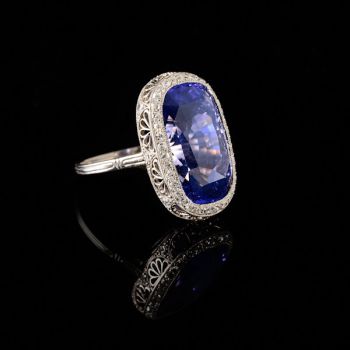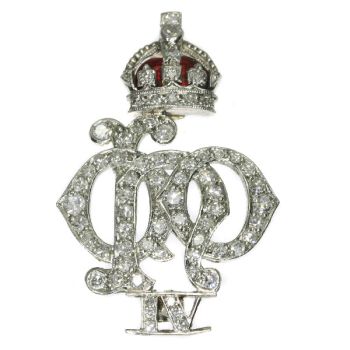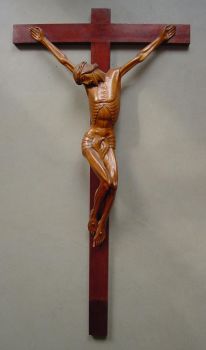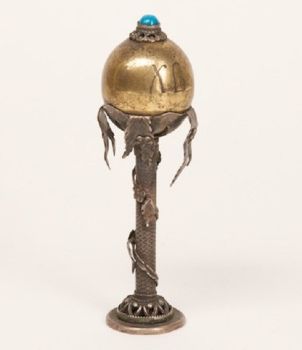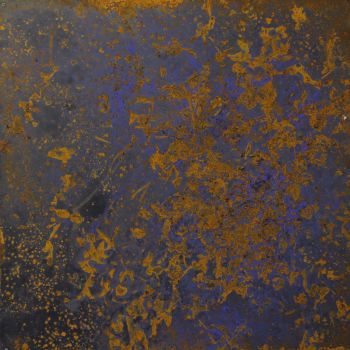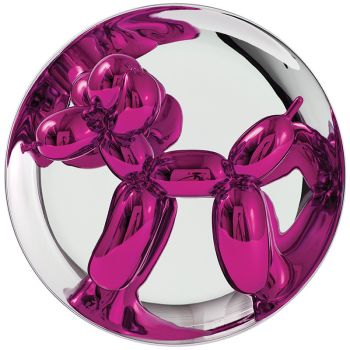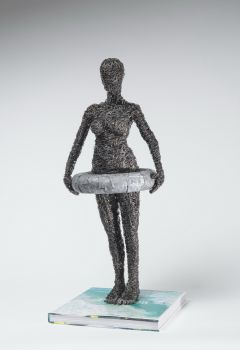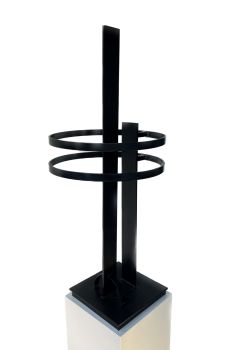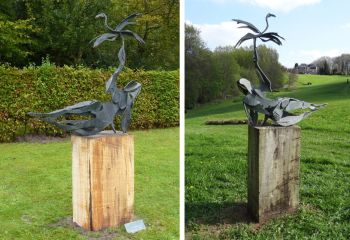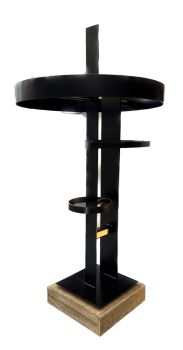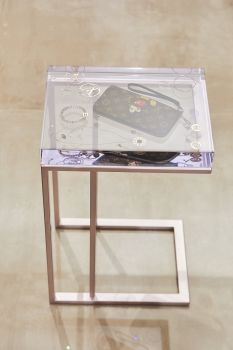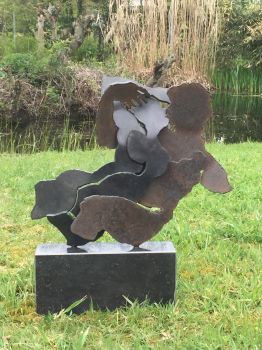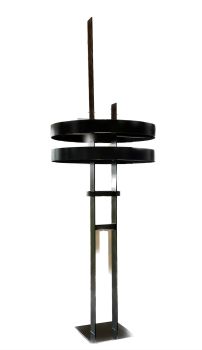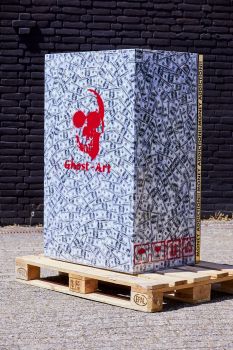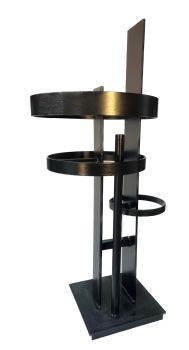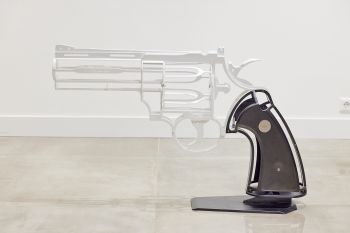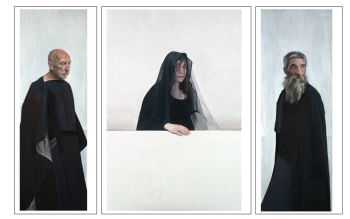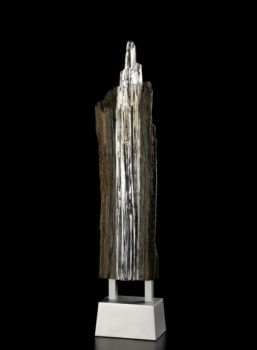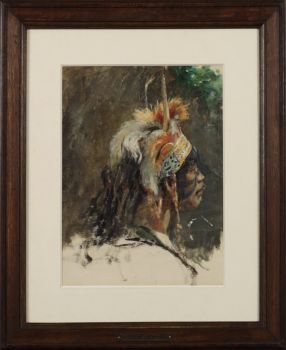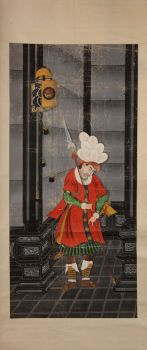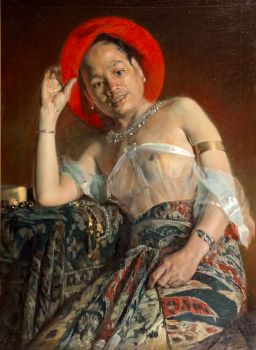A superb inlaid walrus ivory and blue glass Ottoman knife 1700
Artista Sconosciuto
ossoBicchiereAcciaioAvorioMetallo
Prezzo su richiesta
Zebregs & Röell - Fine Art - Antiques
- A proposito di opere d'arteA superb inlaid walrus ivory and blue glass Ottoman knife
Ottoman Empire, Turkey, probably Constantinople (Istanbul), late 17th/early 18th-century
The hilt is formed of a faceted blue glass, while the blade of steel exhibits faux-watering and is inset with beads of coral at three equidistant slots just beneath the spine. The surface of the blade has also been etched over the greater part of its length with an inscription on one face with a part of the Nada ‘Ali quatrain and on the other with “… Muluk (?) sultan malik tahir (?)” (“… of Kings (?), Sultan Malik Tahir (?)”) among vine tendrils that exhibit remnants of the original gilding. Gilt stellar motifs also line the spine of the blade.
The scabbard is inset with a generous array of khatamkari roundels depicting celestial motifs with gems, mother-of-pearl and various metals. Of particular splendour are the ebony tesserae, which are overlaid with pointed stars in gold, some of the larger examples decorated at their centres with an inset turquoise or gold concentric circles. The craftsman has expended great efforts to ensure almost no space is left unfilled, inviting the spectator to inspect the scabbard’s surface as one might survey a busy night-sky. It is interesting to note, too, that the central roundel of the front face is decorated on a shimmering white ground in mother-of-pearl, whilst that on the reverse is black (ebony), as if the front and reverse of the scabbard signified the day and night skies respectively. The scabbard’s gilt-silver collar and chape are punched and chased to depict stylised leaves and roundels in imitation of the scabbard’s central surface, and are further inset with small turquoises as well as coloured gem stones, the chape terminating in a cross-hatched acorn finial.
L. 19.7 cm
Provenance:
With Runjeet Singh, London
This remarkable knife brilliantly exemplifies the artistry so often applied to exceptional pieces of arms and armour, its scabbard proficiently decorated throughout with roundels in a dazzling array of colours and patterns.
Remarkably, the side of the scabbard shows a zig-zag motif, to some immediately recognizable from Japanese Namban export lacquer ordered by the Portuguese. This lacquerware was not intended for the Portuguese market only and was often given as diplomatic gifts to different courts – also to the Ottoman court. The resemblance is so uncanny that it is tempting to suggest that the craftsman took inspiration from such a piece. After all, it is widely known that at the Ottoman court, too, Chinoiserie was in fashion.
A very comparable knife and scabbard can be found in the Schatzkammer of the Bavarian Palace in Munich (inv.no. 1235 or 1819/20). It probably entered the collection through the Pfälzer Wittelsbacher line, who in the 16th and 17th century were known to collect Ottoman artefacts as Turquerie, also known as Turkomania, was in vogue.
A miniature sword in the Walters Art Museum (access.no. 51.79) exhibits a similar sequence of insets along the back-edge of its blade. - A proposito di opere artista
Può succedere che un artista o un creatore sia sconosciuto.
Alcune opere non sono determinate da chi sono state realizzate o sono state realizzate da (un gruppo di) artigiani. Esempi sono statue dell'antichità, mobili, specchi o firme non chiare o leggibili ma anche alcune opere non sono affatto firmate.
Inoltre puoi trovare la seguente descrizione:
•"Attribuito a …." A loro avviso probabilmente opera dell'artista, almeno in parte
•“Studio di ….” o “Officina di” A loro avviso un'opera eseguita nello studio o nella bottega dell'artista, eventualmente sotto la sua supervisione
•“Cerchio di…” A loro avviso un'opera del periodo dell'artista che mostra la sua influenza, strettamente legata all'artista ma non necessariamente al suo allievo
•"Stile di..." o "Seguace di..." A loro avviso un'opera eseguita nello stile dell'artista ma non necessariamente da un allievo; può essere contemporaneo o quasi contemporaneo
•“Modalità di…” A loro avviso un'opera nello stile dell'artista ma di epoca successiva
•"Dopo …." A loro avviso una copia (di qualsiasi data) di un'opera dell'artista
•“Firmato…”, “Datato…” o “Iscritto” A loro avviso l'opera è stata firmata/datata/inscritta dall'artista. L'aggiunta di un punto interrogativo indica un elemento di dubbio
•"Con firma....", "Con data...", "Con iscrizione..." o “Riporta firma/data/iscrizione” a loro avviso la firma/data/iscrizione è stata aggiunta da qualcuno diverso dall'artista
Sei interessato ad acquistare questa opera d'arte?
Artwork details
Related artworks
Artista Sconosciuto
Anello edoardiano con zaffiro cangiante1910 - 1920
Prezzo su richiestaAns Hemke-Kuilboer Juwelier & Antiquair
Artista Sconosciuto
Uovo di Pasqua di presentazione russo d'argento1880 - 1899
Prezzo su richiestaH.W.C. Dullaert Art & Antiques Dealer
1 - 4 / 12Artista Sconosciuto
UN RARO SADELI INDIANO COMPLETO DI LAVORO E SCRITTURA INTARSIATI1800 - 1850
Prezzo su richiestaZebregs & Röell - Fine Art - Antiques
Artista Sconosciuto
The Stamford Raffles Secretaires.1800 - 1813
Prezzo su richiestaZebregs & Röell - Fine Art - Antiques
Artista Sconosciuto
UN MODELLO GIAPPONESE DI UN NORIMONO, UN PALANQUIN1650 - 1700
Prezzo su richiestaZebregs & Röell - Fine Art - Antiques
Artista Sconosciuto
UN NETSUKE IN AVORIO DI UN OLANDESE CHE GIOCA CON UN RAGAZZINO18th century
Prezzo su richiestaZebregs & Röell - Fine Art - Antiques
Artista Sconosciuto
COPPIA DI TORCHÈRE O PORTACANDELE IN TEAK INDONESI LACCATI E DORATI18th century
Prezzo su richiestaZebregs & Röell - Fine Art - Antiques
Artista Sconosciuto
UN CONTENITORE PER DOCUMENTI DELLO SRI LANKA IN ARGENTO DORATO19th century
Prezzo su richiestaZebregs & Röell - Fine Art - Antiques
Artista Sconosciuto
UN RARO GRANDE TELESCOPIO GIAPPONESE IN PELLE LACCATA1750 - 1800
Prezzo su richiestaZebregs & Röell - Fine Art - Antiques
Artista Sconosciuto
UN PICCOLO NETSUKE IN AVORIO DI UN OLANDESE CON UN TAMBURO1750 - 1800
Prezzo su richiestaZebregs & Röell - Fine Art - Antiques
Johannes La (le) Blanck
Un set di ampolle d'argento olandese a doppio uso1786
Prezzo su richiestaJacob J. Roosjen SRI
Artista Sconosciuto
UN NETSUKE IN AVORIO DI UN OLANDESE CHE TIENE UN GALLETTO18th century
Prezzo su richiestaZebregs & Röell - Fine Art - Antiques
1 - 4 / 24Artista Sconosciuto
UN NETSUKE IN AVORIO DI UN OLANDESE CHE TIENE UN GALLETTO18th century
Prezzo su richiestaZebregs & Röell - Fine Art - Antiques
Artista Sconosciuto
UN RARO SADELI INDIANO COMPLETO DI LAVORO E SCRITTURA INTARSIATI1800 - 1850
Prezzo su richiestaZebregs & Röell - Fine Art - Antiques
Artista Sconosciuto
UN PICCOLO NETSUKE IN AVORIO DI UN OLANDESE CON UN TAMBURO1750 - 1800
Prezzo su richiestaZebregs & Röell - Fine Art - Antiques
1 - 4 / 24Shiba Kokan
Dipinto di un olandese di fantasiaearly 19th
Prezzo su richiestaZebregs & Röell - Fine Art - Antiques
Paulus Franciscus Kromjong
Fiori davanti ad Arearea Aka (gioia) di Gauguin'20th century
Prezzo su richiestaZebregs & Röell - Fine Art - Antiques
Artista Sconosciuto
UN NETSUKE IN AVORIO DI UN OLANDESE CHE TIENE UN GALLETTO18th century
Prezzo su richiestaZebregs & Röell - Fine Art - Antiques
1 - 4 / 12







